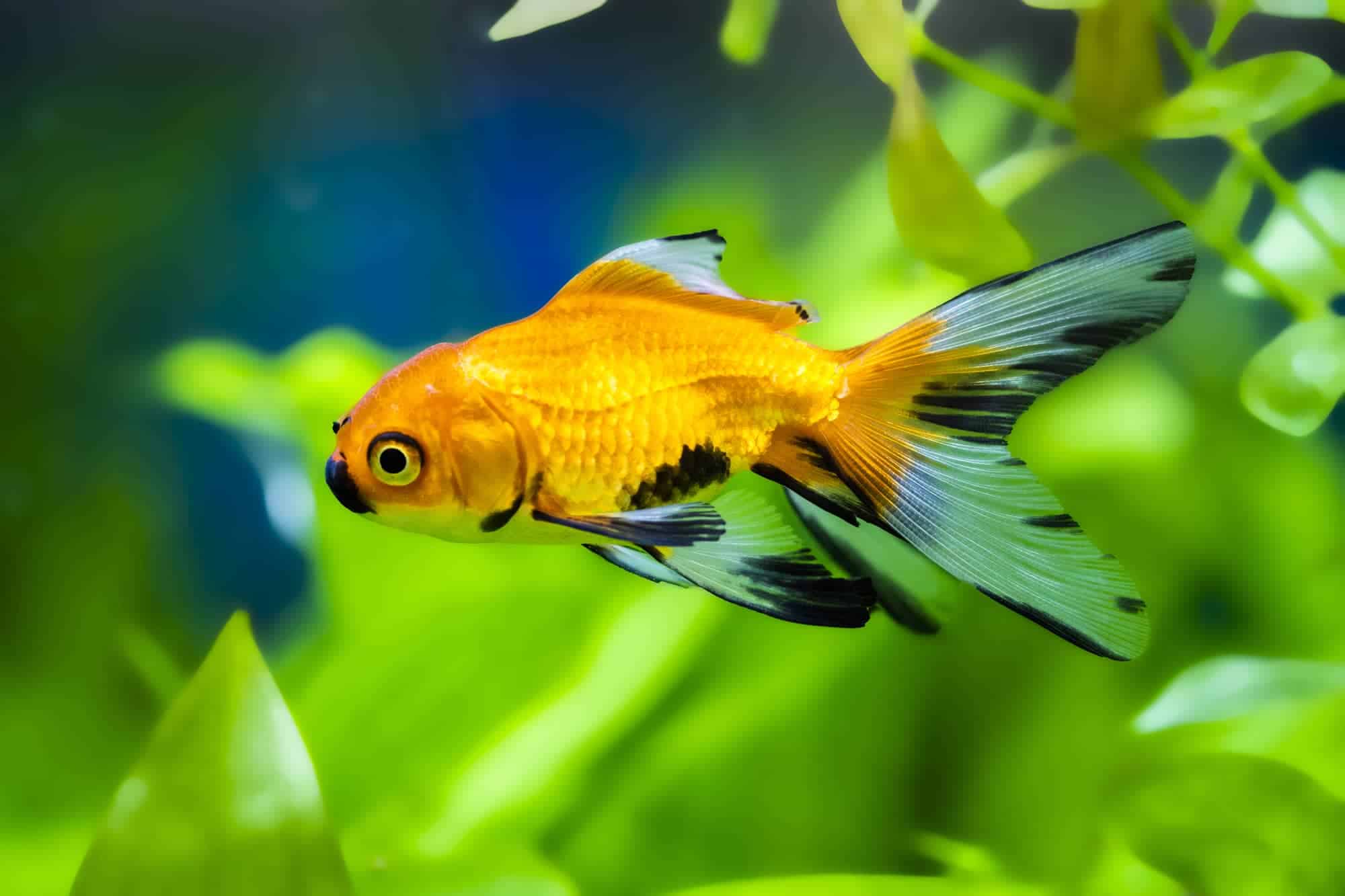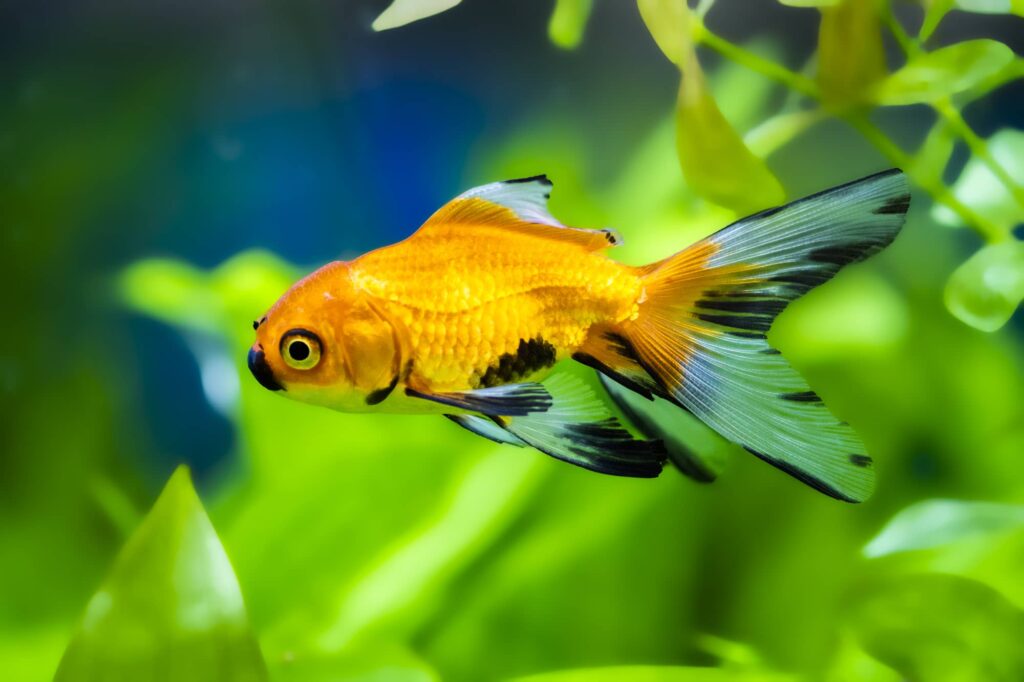It’s in the name: goldfish are gold. So why is yours turning black?
Unfortunately, this isn’t good news and your fish might be suffering from ammonia poisoning. But don’t worry, with some quick correction to water parameters, your fish will be back to its bright metallic coloration in no time!
Keep reading to find out why your goldfish might be turning black and how to save your fish as quickly as possible!
Why Is Your Goldfish Turning Black?
A fish changing color is usually never a good sign, and this is one such case. Goldfish should never turn black!
You should be concerned if black spots start appearing on the body or fins of your fish. A black vignette may even start to creep in from the edges of your fish’s fin.
None of this is normal and indicates that something is going wrong in the tank! This is usually a telltale sign of ammonia poisoning, though fin rot and black spot disease are possibilities as well.
Ammonia Poisoning
One of the first things hobbyists learn about is the aquarium nitrogen cycle.
This is the process by which beneficial bacteria grow in the aquarium, allowing incoming waste to be turned from toxic ammonia and nitrite into safer nitrate.
If the aquarium is not fully cycled, then it will be unable to safely convert any waste made by fish or invertebrates, leaving ammonia levels to rise and become deadly. This leads to ammonia poisoning.
Ammonia is toxic and will burn internal and external skin at high levels. These are chemical burns that will appear as black spots or black fins on your fish.
Other signs to look out for are:
- Lethargy
- Lack of appetite
- Gasping for air
- Redness around the gills
For the most part, these symptoms will set in almost immediately if ammonia levels are too high. However, this can also become a chronic condition if there are consistently low levels of ammonia present in the aquarium.
Why Is There Ammonia in Your Aquarium?
If you have adequate filtration, perform regular water changes, and the aquarium is fully cycled, you might be asking yourself why there is still ammonia in your aquarium.
At any given time, there is ammonia present in the aquarium. There is a constant influx of waste that is getting converted to nitrite and nitrate and a negligible amount is normal.
However, goldfish are particularly messy fish that create much more waste than the average tropical species.
This, in addition to many goldfish being kept in an improper aquarium size or setup, often leads to a lot of uneaten food and waste that overloads the system.
Ammonia levels can increase with feedings, fish growth, or lack of general tank maintenance. Find out how to lower your ammonia with these easy steps.
How Much Ammonia Is Too Much?

In reality, any amount of ammonia is too much.
Test kits should always read 0 ppm ammonia, 0 ppm nitrite, and low nitrates. Remember that there are still small amounts to keep the nitrogen cycle running, though.
If you’re struggling with your parameters, there are some important ammonia levels to keep in mind.
It’s generally accepted that anything under 0.25 ppm ammonia is safe in the short term. This isn’t to say that it isn’t affecting fish and invertebrates, but your tank inhabitants will be able to withstand these levels for short periods if completely necessary.
At these levels, your fish might not show any signs of suffering but your tank may be cloudy and have a distinct ammonia smell. This will only continue to worsen as conditions deteriorate.
The other ammonia level that you need to keep in mind is 5.0 ppm. This is incredibly toxic and will stall a nitrogen cycle, meaning the beneficial bacteria are unable to complete their processes.
By this point, fish will long be dead. The bigger concern is getting your fish tank back on track to a healthy nitrogen cycle.
This will mean consistent water changes and testing water parameters until ammonia has been lowered. It is also recommended to supplement beneficial bacteria and use detoxifiers to help stabilize the system.
Fin Rot
Fin rot is another reason why your goldfish might be turning black.
Fin rot can be a bacterial or fungal infection that is the result of poor water quality and overall bad aquarium conditions.
There is no one exact cause of fin rot. It is a secondary infection to a larger problem in the goldfish tank, like the stress of bad water parameters.
For example, your fish may get fin rot after scratching against something in a tank with poor water quality. While most healthy fish can fight these minor infections, fin rot will take hold if the fish is already weakened.
Black spots are not a common symptom of fin rot, but might appear around injured or inflamed areas; the edges of the fins may also turn black as they start to wither and tear.
Other signs of fin rot include:
- Lethargy
- Lack of appetite
- Frayed fins
- Discoloration
- Inflamed and open sores
Luckily, fin rot is pretty straightforward to cure and easy to prevent. It can be very painful for fish though, so it’s important to start improving living conditions as soon as possible!
For a full guide on understanding fin rot and how to treat these aquarium infections, make sure to check out our article here.
Black Spot Disease
As its name implies, black spot disease could be one of the reasons your goldfish is changing color.
This isn’t a common disease to find in the aquarium and even less likely that it’s the cause of your fish’s suffering, but you shouldn’t rule it out entirely.
Black spot disease is the result of a freshwater fluke parasite from the genus Neascus. The larvae of this parasite burrow into fish skin. The skin then covers the larvae with a black pigmented spot.
This can result in a cluster of black specks all across the body of your fish. At first, they’ll look like a natural change in color, but don’t be fooled!
These parasites enter the aquarium through water snails. Luckily, they then need to be transmitted by birds, eliminating most concerns for aquarium keepers.
However, this can become a problem for enthusiasts keeping goldfish in outdoor ponds where the parasitic cycle can be completed.
Are Goldfish Ever Supposed to Turn Black?
Some fish are known for changing colors, like the koi betta fish. Goldfish come in lots of colors and varieties, so there must be some that change color at one point or another, right?
There are many varieties of goldfish out there–even the Black Moor goldfish whose natural color is black–but they’re never supposed to turn from one color to another.
This is especially true if the original color of your fish is a lighter normal color, like gold or white.
In short, no, goldfish are never supposed to turn black and any development of dark spots on the body or fins of your fish should be taken seriously.
How To Stop Your Goldfish from Turning Black
If you find that your fish is starting to form black patches, you’ll want to fix the problem as soon as you notice it.
Ammonia poisoning can be fixed with a series of water changes and additional bacteria supplements and detoxifiers, like Seachem Prime, can be used for temporary relief.
The easiest way to prevent ammonia from accumulating in the first place is by allowing the fish tank to fully cycle and performing regular aquarium maintenance. Also, make sure that filtration is fitted for the tank and bioload without overstocking.
Fin rot will also be helped by a series of water changes. The trick to curing fin rot is being consistent without stressing out the fish too much, which could prolong symptoms.
To prevent fin rot from ever taking hold, regularly test water parameters and keep up with water changes to remove leftover food and other fish waste. Many fish can enter the new aquarium already having fin rot, so be prepared if it develops within the first few weeks of having the fish.
Black spot disease is rare to come across, but not impossible to find. As mentioned before, this parasite will likely leave on its own due to a lack of birds that act as hosts.
While your fish is infected, keep water parameters up and make sure that your fish is staying fed. To keep your fish from further injuring itself, use a quarantine system.
This will also allow you to dose more effective medications, like copper, which shouldn’t be dosed in the main aquarium otherwise.
Conclusion
Goldfish should stay gold! If you find that your goldfish is developing black patches on its body or fins, then there’s something wrong!
This is most likely due to ammonia burns, fin rot, or black spot disease. All of these can prove to be deadly even though treatments are rather quick and straightforward.
If you have any questions about why your goldfish might be turning black, other goldfish health concerns, or have had experience treating a sick fish that’s changing colors, don’t hesitate to leave a comment below!


